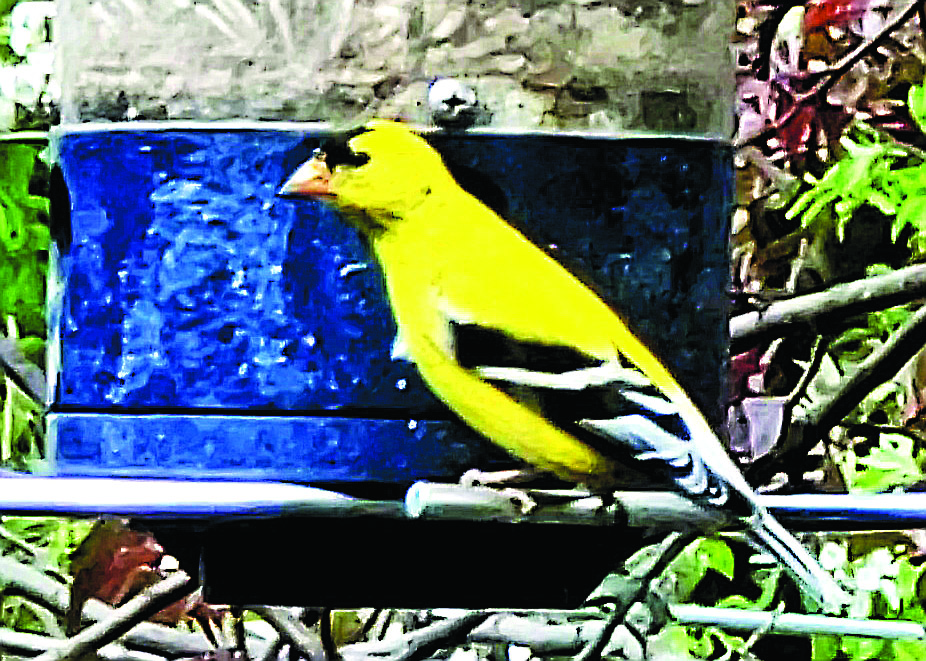
Goldfinch
Nancy Edmonds Hanson
One of the year’s most spectacular parades is drawing to a close – the spring migration of birds that wintered in the south as they fly northward to raise their young.
“We’re just past the peak of the migration,” says Dr. Joseph Whittaker, an assistant professor of biology at Concordia College. “We’re seeing lots of warblers and sparrows now. Soon they’ll be settling down to nest and raise their fledglings.”
Whittaker conducted River Keepers’ and Audubon Dakota’s annual bird-watching expedition last week from a canoe on the Red River. He concedes it was less than a rousing success, but fun all the same: “Evening isn’t the best time to see birds. Early morning is better. We heard a lot more than we saw. But the river offers a different viewpoint … and paddling is fun.”
But those who forswear paddling have an excellent view of the annual parade as well, right in their own back yards. From sparrows, robins, pine siskins and nuthatches to colorful celebrities like orioles, hummingbirds, tanagers, buntings and, increasingly, cardinals, the Red River draws more than 200 species to the “gallery forest” lining its banks.
“They come up the Mississippi River Valley to the Minnesota River and on to the Red,” Whittaker says. “It’s a nice migration corridor for those headed for both the forests and prairies – a great place to stop, rest and feed on insects.”
Whether due to last winter’s severe storms in Texas, or to the gradual shift in climate, bird experts are seeing some changes in this year’s parade. “It’s weird. It seems to have slowed the migrants down,” Whittaker says. One of his colleagues at Itasca State Park, where he’s currently teaching a field course for the University of Minnesota, has observed a dramatic decrease in the population of bluebirds arriving this spring: “She is seeing one or two of them arriving, rather than the dozens she’d expect by now.”
The professor, who earned his advanced degrees through the University of Minnesota’s campus in Duluth, has been teaching summer courses at the U’s field station since 2004 – seven years before he joined Concordia’s biology department. He is leading field studies for the next two weeks in small mammals.
Interest in the area’s bounty of birds, he suggests, seems to be growing. “It may be related to the pandemic and staying closer to home,” he says. “The birds have always been there, but perhaps they’re catching more of people’s attention as they have looked for more individual activities outdoors.”
He has several simple tips for increasing bird traffic in your back yard. Offering a buffet of foods that suit different palates is the most basic. But filling the feeders is just the beginning. “You need to empty and clean the feeders from time to time so that fungi don’t grow there,” he suggests. The same goes for hummingbird and oriole feeders filled with sugar water: “They need to be changed every few days – probably more regularly than you think they do. Native plantings also help.”
Most of all, he says, “Be observant. Now that the trees have leafed out fully, it can be a little harder to spot them. Listen for bird songs, then try to follow the sound.”
The benefits of bringing birding into your life, he says, can go much farther than enjoying a relaxing pastime.
“Getting to know birds is a way of immersing yourself in the interconnectedness we all share. Birds – like bees and other insects – are a good barometer of our environment.” He continues, “Small changes affect our world on a scale that’s quite surprising. As you appreciate one kind of life, it’s hard to overlook the way everything ties together.
“There’s pretty good evidence that our disrespect of the environment resulted in the pandemic. We need to put our priorities in the right places.”


